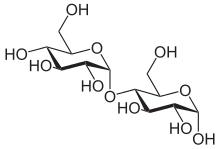Maltose/ja: Difference between revisions
Created page with "植物以外では、マルトースはシュガーバッグにも含まれている(と思われる)。" Tags: Mobile edit Mobile web edit |
Created page with "ヒトでは、マルトースは様々なマルターゼ酵素によって分解され、エネルギーを供給するために分解されるか、グリコーゲンとして貯蔵されるさらに処理されることができる2つのグルコース分子を提供する。ヒトにおいてスクロースイソマルターゼ酵素が欠損しているとスクロース不耐症を引..." |
||
| Line 97: | Line 97: | ||
植物以外では、マルトースは[[sugarbag/ja|シュガーバッグ]]にも含まれている(と思われる)。 | 植物以外では、マルトースは[[sugarbag/ja|シュガーバッグ]]にも含まれている(と思われる)。 | ||
ヒトでは、マルトースは様々なマルターゼ酵素によって分解され、エネルギーを供給するために分解されるか、グリコーゲンとして貯蔵される[[glucose metabolism/ja|さらに処理される]]ことができる2つのグルコース分子を提供する。ヒトにおいて[[sucrase-isomaltase/ja|スクロースイソマルターゼ]]酵素が欠損していると[[sucrose intolerance/ja|スクロース不耐症]]を引き起こすが、4つの異なるマルターゼ酵素が存在するため、完全なマルトース不耐症は極めてまれである。 | |||
==外部リンク== | ==外部リンク== | ||
Revision as of 20:10, 21 April 2024
 α-Maltose
| |
 β-Maltose
| |
| Names | |
|---|---|
| IUPAC name
4-O-α-D-Glucopyranosyl-D-glucose
| |
| Systematic IUPAC name
(3R,4R,5S,6R)-6-(hydroxymethyl)-5-{[(2R,3R,4S,5S,6R)-3,4,5-trihydroxy-6-(hydroxymethyl)oxan-2-yl]oxy}oxane-2,3,4-triol | |
| Identifiers | |
3D model (JSmol)
|
|
| ChEBI | |
| ChEMBL | |
| ChemSpider | |
| EC Number |
|
| KEGG | |
PubChem CID
|
|
| UNII | |
| |
| |
| Properties | |
| C12H22O11 | |
| Molar mass | 342.297 g·mol−1 |
| Appearance | White powder or crystals |
| Density | 1.54 g/cm3 |
| Melting point | 160 to 165 °C (320 to 329 °F; 433 to 438 K) (anhydrous) 102–103 °C (monohydrate) |
| 1.080 g/mL (20 °C) | |
Chiral rotation ([α]D)
|
+140.7° (H2O, c = 10) |
| Hazards | |
| Safety data sheet (SDS) | External MSDS |
| Related compounds | |
Related
|
Sucrose Lactose Trehalose Cellobiose |

マルトース(/ˈmɔːltoʊs/または/ˈmɔːltoʊz/)は、マルトビオースまたは麦芽糖としても知られ、α(1→4)結合で結合した2単位のグルコースから形成される二糖である。異性体イソマルトースでは、2つのグルコース分子がα(1→6)結合で結合している。マルトースは、デンプンの重要な構造モチーフであるアミロース相同系列の2単位のメンバーである。β-アミラーゼがデンプンを分解する際、一度に2つのグルコースを除去し、マルトースを生成する。この反応の例は発芽する種子に見られ、これが麦芽の名前の由来となっている。スクロースとは異なり、還元糖である。
History
Maltose was discovered by Augustin-Pierre Dubrunfaut, although this discovery was not widely accepted until it was confirmed in 1872 by Irish chemist and brewer Cornelius O'Sullivan. Its name comes from malt, combined with the suffix '-ose' which is used in names of sugars.
Structure and nomenclature
Carbohydrates are generally divided into monosaccharides, oligosaccharides, and polysaccharides depending on the number of sugar subunits. Maltose, with two sugar units, is a disaccharide, which falls under oligosaccharides. Glucose is a hexose: a monosaccharide containing six carbon atoms. The two glucose units are in the pyranose form and are joined by an O-glycosidic bond, with the first carbon (C1) of the first glucose linked to the fourth carbon (C4) of the second glucose, indicated as (1→4). The link is characterized as α because the glycosidic bond to the anomeric carbon (C1) is in the opposite plane from the CH
2OH substituent in the same ring (C6 of the first glucose). If the glycosidic bond to the anomeric carbon (C1) were in the same plane as the CH
2OH substituent, it would be classified as a β(1→4) bond, and the resulting molecule would be cellobiose. The anomeric carbon (C1) of the second glucose molecule, which is not involved in a glycosidic bond, could be either an α- or β-anomer depending on the bond direction of the attached hydroxyl group relative to the CH
2OH substituent of the same ring, resulting in either α-maltose or β-maltose.
An isomer of maltose is isomaltose. This is similar to maltose but instead of a bond in the α(1→4) position, it is in the α(1→6) position, the same bond that is found at the branch points of glycogen and amylopectin.
Properties
Like glucose, maltose is a reducing sugar, because the ring of one of the two glucose units can open to present a free aldehyde group; the other one cannot because of the nature of the glycosidic bond. Maltose can be broken down to glucose by the maltase enzyme, which catalyses the hydrolysis of the glycosidic bond.
Maltose in aqueous solution exhibits mutarotation, because the α and β isomers that are formed by the different conformations of the anomeric carbon have different specific rotations, and in aqueous solutions, these two forms are in equilibrium. Maltose can easily be detected by the Woehlk test or Fearon's test on methylamine.
It has a sweet taste, but is only about 30–60% as sweet as sugar, depending on the concentration.
供給源と吸収

麦芽糖は麦芽の成分であり、穀物を水で柔らかくし、発芽させたときに得られる物質である。また、マルトデキストリン、コーンシロップ、酸で薄めた澱粉のような部分加水分解澱粉製品にも非常に様々な量で含まれている。
植物以外では、マルトースはシュガーバッグにも含まれている(と思われる)。
ヒトでは、マルトースは様々なマルターゼ酵素によって分解され、エネルギーを供給するために分解されるか、グリコーゲンとして貯蔵されるさらに処理されることができる2つのグルコース分子を提供する。ヒトにおいてスクロースイソマルターゼ酵素が欠損しているとスクロース不耐症を引き起こすが、4つの異なるマルターゼ酵素が存在するため、完全なマルトース不耐症は極めてまれである。
外部リンク
 Media related to Maltose/ja at Wikimedia Commons
Media related to Maltose/ja at Wikimedia Commons- Maltose, Elmhurst College Virtual Chembook.